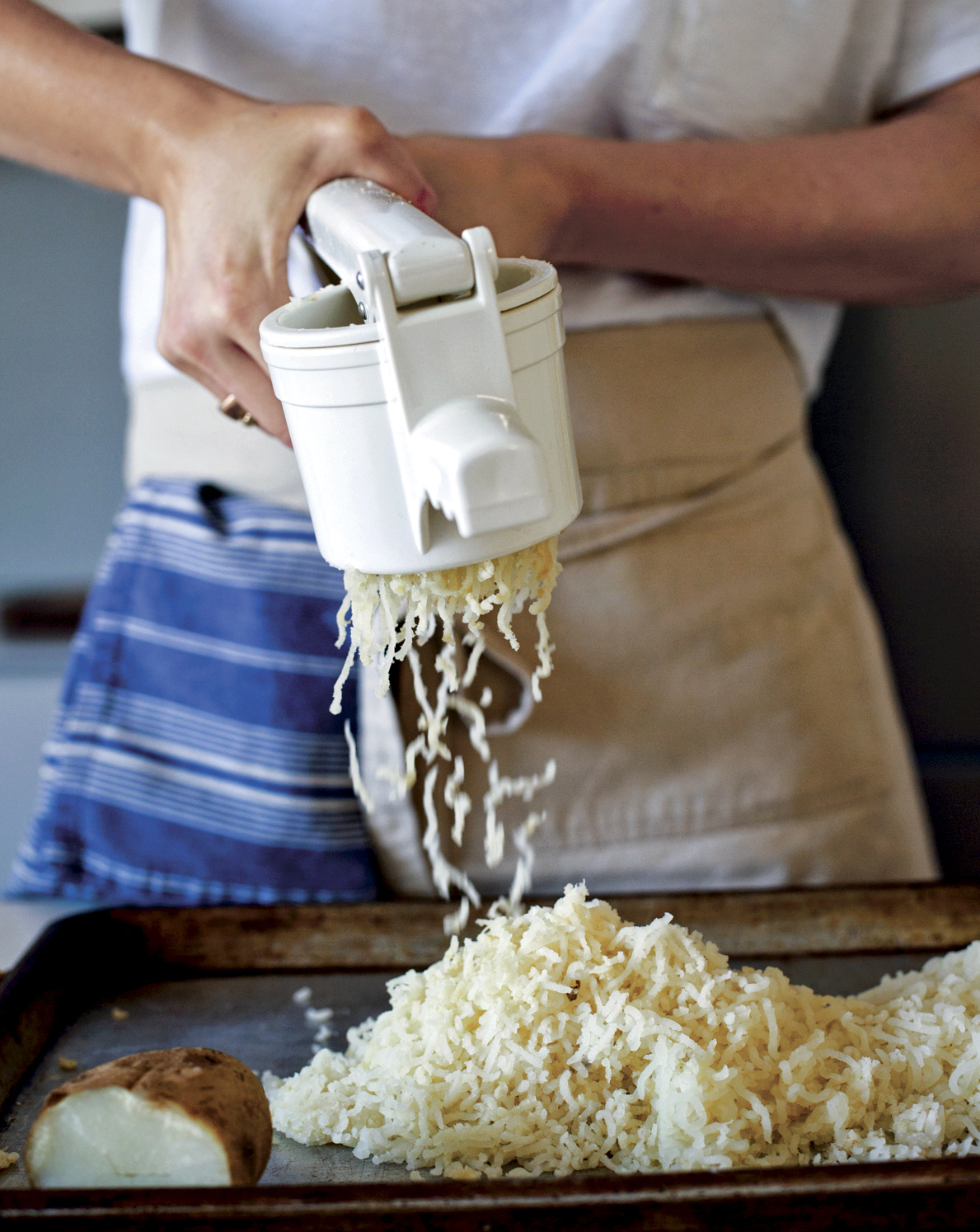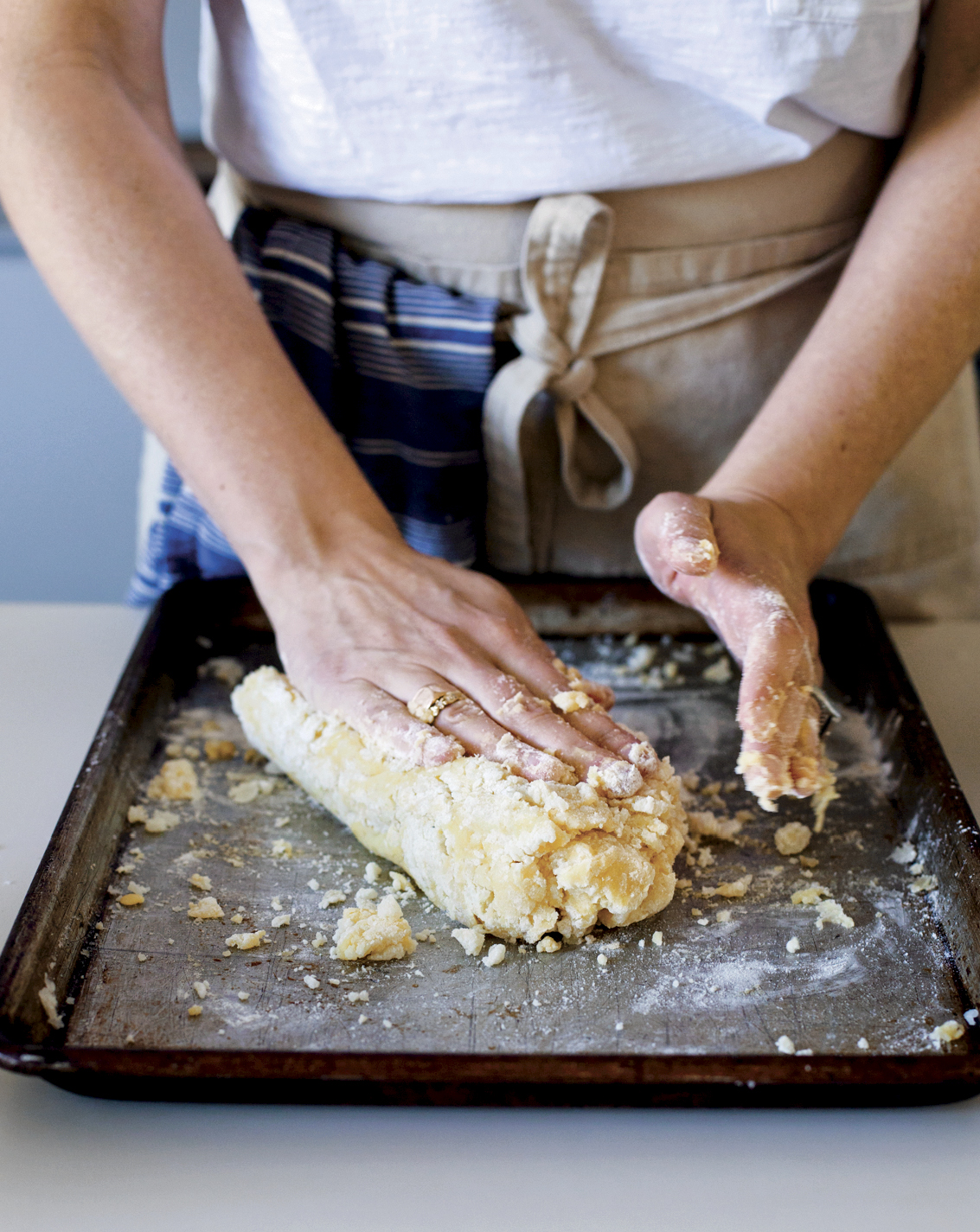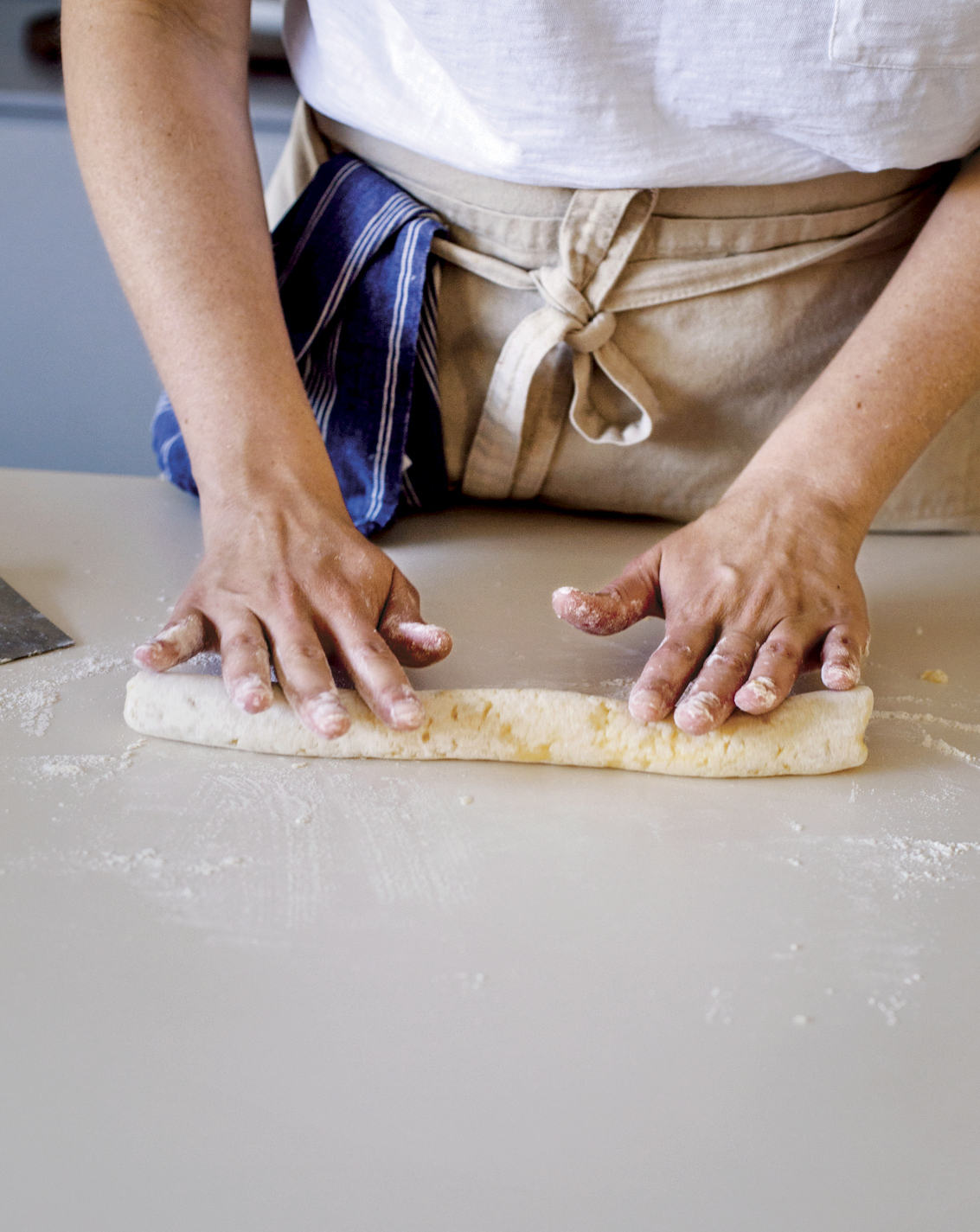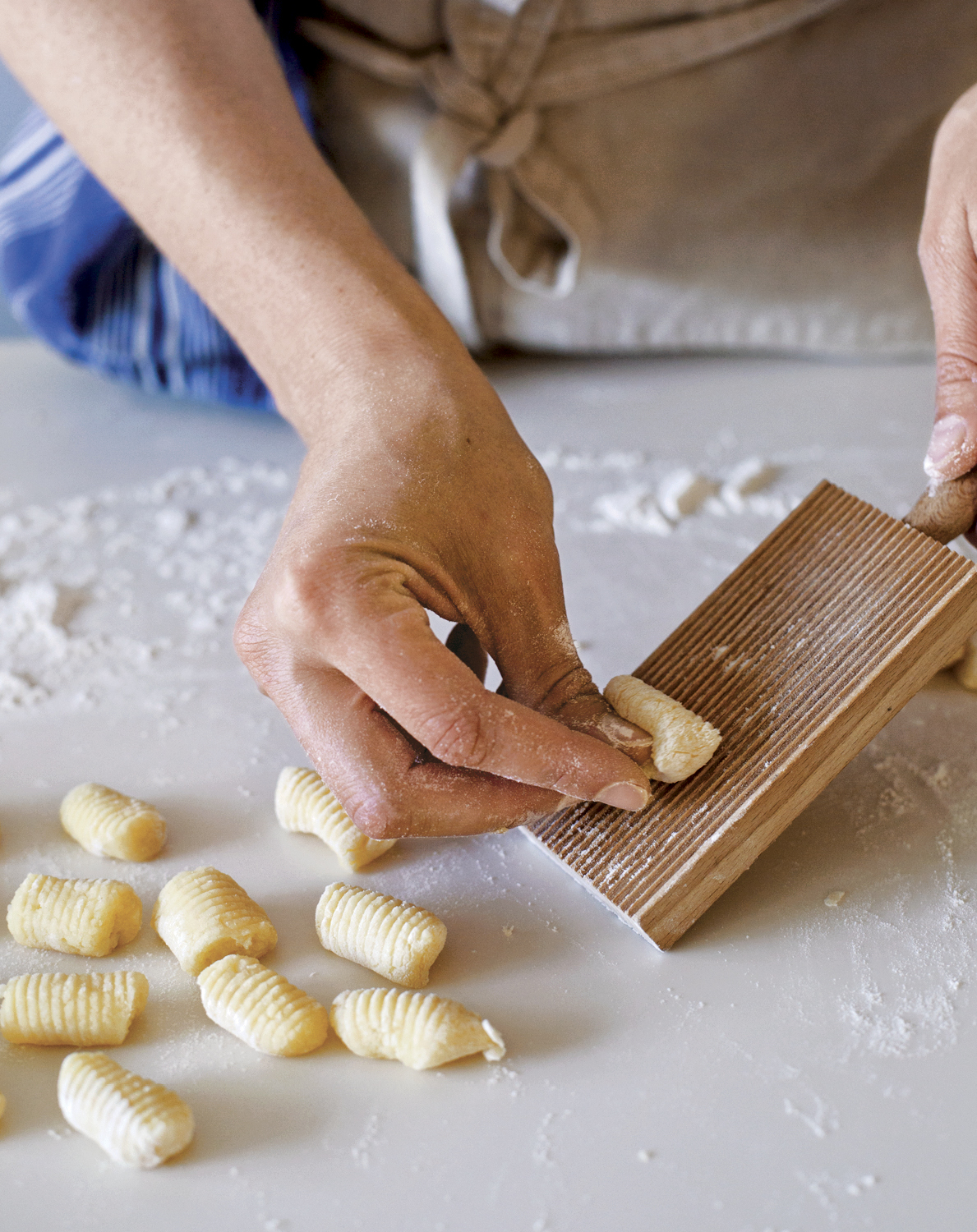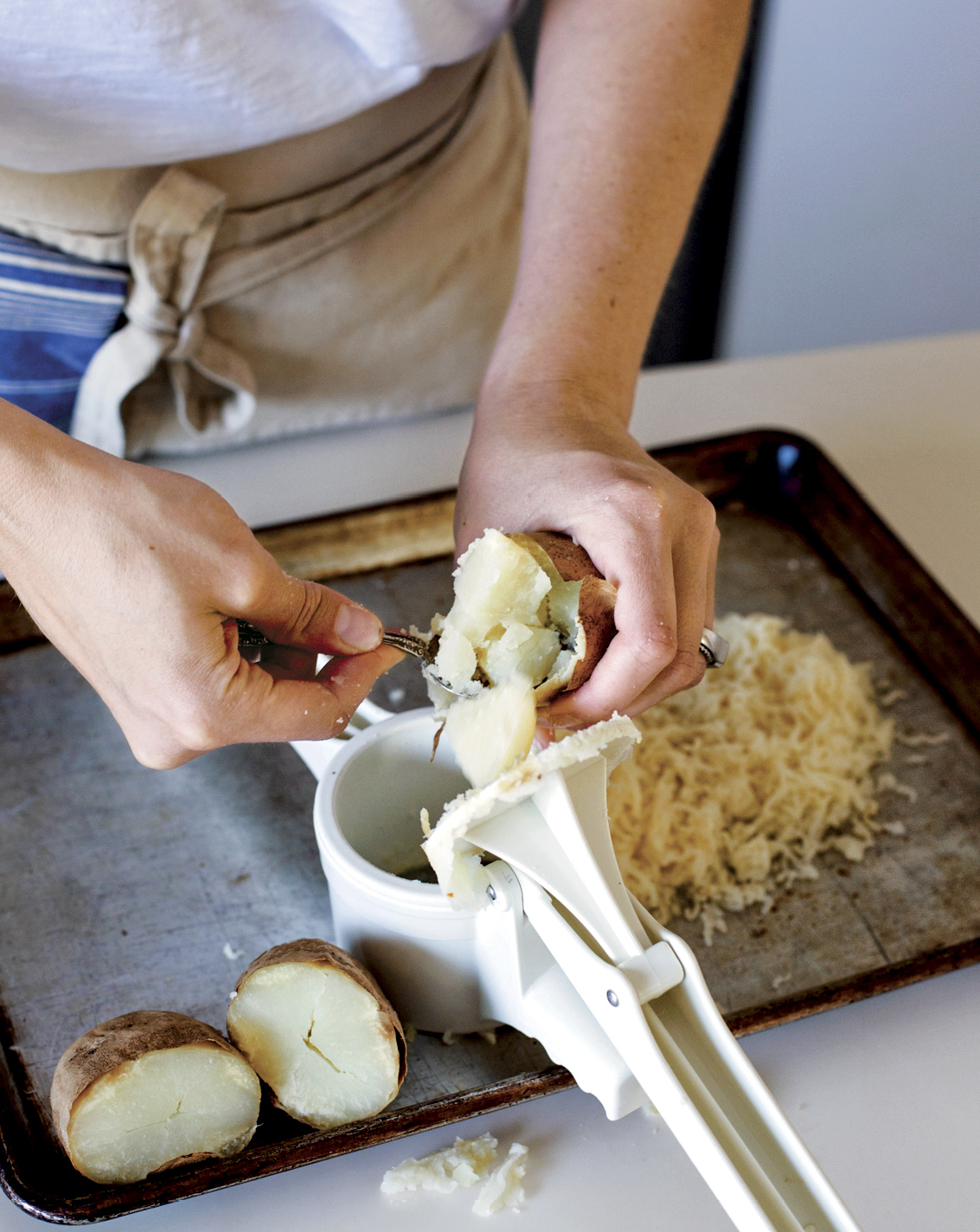Brown-Butter Gnocchi with Crispy Prosciutto and Sage
Serves 4
WHEN I WAS A KID, I’d always ask for meat loaf and mashed potatoes as my birthday meal. And these days, when I’m sick or sad, I bake myself a potato and load it with pats of salted butter.
Gnocchi, which likely originated in northern Italy, is a pasta made from potatoes, and it’s really just a sophisticated form of comfort food. I’ve never particularly liked the combination of gnocchi with tomato sauce; the sauce masks their delicate flavor. But gnocchi tossed in nutty brown butter with crispy bits of prosciutto and sage leaves? That makes sense.
Adding too much flour to gnocchi dough can cause them to be leaden and dense, but if you don’t add enough, they’ll fall apart when boiled. Practice makes perfect—you’re looking for a dough that is soft but not sticky, and the amount of flour that you add to each batch may change, since the moisture content of the potatoes (and flour) can vary.
2 pounds russet potatoes (about 3 medium)
6 tablespoons unsalted butter
1 egg
¼ cup plus 2 tablespoons finely grated Parmigiano-Reggiano
1 teaspoon kosher salt
1 cup all-purpose flour
Extra-virgin olive oil
4 ounces thinly sliced prosciutto
15 sage leaves
Freshly ground pepper
 Preheat the oven to 400°F. Rinse the potatoes and place them on a rimmed baking sheet. With a fork, poke holes in each potato. Bake until tender, about 1 hour. Remove from the oven and when just cool enough to handle but still very warm, split the potatoes in half and scoop out the flesh. Discard the skin. Pass the potato flesh through a ricer onto a rimmed baking sheet and spread in an even layer.
Preheat the oven to 400°F. Rinse the potatoes and place them on a rimmed baking sheet. With a fork, poke holes in each potato. Bake until tender, about 1 hour. Remove from the oven and when just cool enough to handle but still very warm, split the potatoes in half and scoop out the flesh. Discard the skin. Pass the potato flesh through a ricer onto a rimmed baking sheet and spread in an even layer.
 Melt 2 tablespoons of the butter. In a small bowl, whisk together the melted butter, egg, 2 tablespoons of the Parmigiano, and the salt. Drizzle over the warm riced potatoes, then sprinkle about ¾ cup of the flour over. With your fingertips, gently work the mixture into a ball. The dough should be soft but not sticky; if it’s sticky, add some of the remaining flour by the tablespoonful. Form the dough into a disk and cut the disk into 1-inch slices. Roll each slice into a ball.
Melt 2 tablespoons of the butter. In a small bowl, whisk together the melted butter, egg, 2 tablespoons of the Parmigiano, and the salt. Drizzle over the warm riced potatoes, then sprinkle about ¾ cup of the flour over. With your fingertips, gently work the mixture into a ball. The dough should be soft but not sticky; if it’s sticky, add some of the remaining flour by the tablespoonful. Form the dough into a disk and cut the disk into 1-inch slices. Roll each slice into a ball.
 Lightly dust a rimmed baking sheet with flour and set nearby. On a lightly floured work surface, working with one ball of dough at a time, roll into a snake about ¾ inch around. Cut each snake crosswise into ¾-inch pieces. Using your thumb and one piece of dough at a time, roll each piece across a gnocchi paddle or the tines of an overturned fork, pressing down lightly so the gnocchi curve around your thumb slightly, then drop onto the prepared baking sheet. Repeat with the remaining balls of dough until all of the gnocchi have been formed. (You can make the gnocchi to this point, freeze them on the baking sheet, and then transfer them to plastic freezer storage bags. They can be boiled from frozen.)
Lightly dust a rimmed baking sheet with flour and set nearby. On a lightly floured work surface, working with one ball of dough at a time, roll into a snake about ¾ inch around. Cut each snake crosswise into ¾-inch pieces. Using your thumb and one piece of dough at a time, roll each piece across a gnocchi paddle or the tines of an overturned fork, pressing down lightly so the gnocchi curve around your thumb slightly, then drop onto the prepared baking sheet. Repeat with the remaining balls of dough until all of the gnocchi have been formed. (You can make the gnocchi to this point, freeze them on the baking sheet, and then transfer them to plastic freezer storage bags. They can be boiled from frozen.)
 Bring a large pot of salted water to a boil. Drizzle a rimmed baking sheet with a small amount of olive oil. When the water is boiling, add the gnocchi to the water in batches. The gnocchi will sink and then float; when they rise to the top, boil them for 2 minutes. With a spider or slotted spoon, transfer the gnocchi to the baking sheet.
Bring a large pot of salted water to a boil. Drizzle a rimmed baking sheet with a small amount of olive oil. When the water is boiling, add the gnocchi to the water in batches. The gnocchi will sink and then float; when they rise to the top, boil them for 2 minutes. With a spider or slotted spoon, transfer the gnocchi to the baking sheet.
 Heat a large nonstick frying pan over medium heat. Lay a few slices of the prosciutto in the pan in a single layer and cook, turning once, until crispy, about 2 minutes. Transfer to a plate and repeat until all of the prosciutto has been fried. Add the remaining 4 tablespoons butter to the pan and, when it melts, add the sage leaves and fry until crisp. Transfer the fried sage to the plate with the prosciutto.
Heat a large nonstick frying pan over medium heat. Lay a few slices of the prosciutto in the pan in a single layer and cook, turning once, until crispy, about 2 minutes. Transfer to a plate and repeat until all of the prosciutto has been fried. Add the remaining 4 tablespoons butter to the pan and, when it melts, add the sage leaves and fry until crisp. Transfer the fried sage to the plate with the prosciutto.
 Let the butter continue to cook until it’s light golden brown and has a nutty aroma. Slide the gnocchi into the pan and, with a rubber spatula, stir gently to coat the gnocchi in butter. Cook without stirring until the gnocchi are heated through and beginning to develop a golden-brown crust on the bottom, about 2 minutes. Crumble the prosciutto into the pan and stir gently with the rubber spatula to combine. Season to taste with salt and pepper, then transfer to a platter and garnish with the fried sage and remaining ¼ cup grated Parmigiano. Serve immediately.
Let the butter continue to cook until it’s light golden brown and has a nutty aroma. Slide the gnocchi into the pan and, with a rubber spatula, stir gently to coat the gnocchi in butter. Cook without stirring until the gnocchi are heated through and beginning to develop a golden-brown crust on the bottom, about 2 minutes. Crumble the prosciutto into the pan and stir gently with the rubber spatula to combine. Season to taste with salt and pepper, then transfer to a platter and garnish with the fried sage and remaining ¼ cup grated Parmigiano. Serve immediately.
